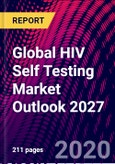Global HIV Self-Testing Market Analysis - 2018-2027
HIV self-testing kits are those rapid diagnostic products which is used to perform the testing of HIV in a private environment through the specimen collected from blood, oral fluid or urine of an individual. The results interpreted through these kits are highly accurate and can be compared to the diagnostics of laboratories. The global HIV self-testing market is anticipated to record a CAGR of 45.62% over the forecast period, i.e. 2020-2025. Factors such as increasing adoption of HIV self-testing kits on the back of increasing public sector funding and collaborations, growing prevalence of HIV across the world, which continues to be a burden for nations around the globe along with the opportunities observed in making HIV kits available in several nations where there are no policies for HIVST are some of the factors anticipated to promote towards the growth of the global HIV self-testing market. A statistical report titled Global AIDS Epidemic by the UNAIDS and World Health Organization (WHO), stated that nearly 770,000 people died of AIDS and around 1.7 million people were affected newly by HIV in the year 2018.
The global HIV self-testing market consists of various segments that are segmented by sample, by product technology, by test generation and by region. The test generation segment is sub-divided into 2nd, 3rd and 4th. Out of these, the 2nd generation segment, which was valued at USD 23.15 million in the year 2018 is anticipated to grow with a CAGR of 44.84% over the forecast period. The second-generation HIV self-testing kits detect the HIV-1 and HIV-2 antibodies. The window period of the second-generation kits is usually longer as compared to the third and fourth generation kits. Most of the products used for HIV self-testing belong to the second generation. The preference for the second-generation HIV self-testing kits is high owing to its lower cost when compared to third and fourth generation self-testing kits.
Based on Region, the global HIV self-testing market is segmented into North America, Europe, Asia Pacific, Latin America and Middle East & Africa. The market in Latin America was valued at USD 1.87 million in the year 2018 and is anticipated to grow with a CAGR of 43.64% over the forecast period. The market is further anticipated to gain an incremental $ opportunity of USD 14.84 million in the year 2025 as compared to the previous year.
Some of the affluent industry leaders in the global HIV self-testing market are OraSure Technologies, Inc., Chembio Diagnostics, Inc., WAMA Diagnostica, ECO Diagnostica, Orange Life and Ebram Produtos Laboratoriais Ltda.
HIV self-testing kits are those rapid diagnostic products which is used to perform the testing of HIV in a private environment through the specimen collected from blood, oral fluid or urine of an individual. The results interpreted through these kits are highly accurate and can be compared to the diagnostics of laboratories. The global HIV self-testing market is anticipated to record a CAGR of 45.62% over the forecast period, i.e. 2020-2025. Factors such as increasing adoption of HIV self-testing kits on the back of increasing public sector funding and collaborations, growing prevalence of HIV across the world, which continues to be a burden for nations around the globe along with the opportunities observed in making HIV kits available in several nations where there are no policies for HIVST are some of the factors anticipated to promote towards the growth of the global HIV self-testing market. A statistical report titled Global AIDS Epidemic by the UNAIDS and World Health Organization (WHO), stated that nearly 770,000 people died of AIDS and around 1.7 million people were affected newly by HIV in the year 2018.
The global HIV self-testing market consists of various segments that are segmented by sample, by product technology, by test generation and by region. The test generation segment is sub-divided into 2nd, 3rd and 4th. Out of these, the 2nd generation segment, which was valued at USD 23.15 million in the year 2018 is anticipated to grow with a CAGR of 44.84% over the forecast period. The second-generation HIV self-testing kits detect the HIV-1 and HIV-2 antibodies. The window period of the second-generation kits is usually longer as compared to the third and fourth generation kits. Most of the products used for HIV self-testing belong to the second generation. The preference for the second-generation HIV self-testing kits is high owing to its lower cost when compared to third and fourth generation self-testing kits.
Based on Region, the global HIV self-testing market is segmented into North America, Europe, Asia Pacific, Latin America and Middle East & Africa. The market in Latin America was valued at USD 1.87 million in the year 2018 and is anticipated to grow with a CAGR of 43.64% over the forecast period. The market is further anticipated to gain an incremental $ opportunity of USD 14.84 million in the year 2025 as compared to the previous year.
Some of the affluent industry leaders in the global HIV self-testing market are OraSure Technologies, Inc., Chembio Diagnostics, Inc., WAMA Diagnostica, ECO Diagnostica, Orange Life and Ebram Produtos Laboratoriais Ltda.
Table of Contents
Global HIV Self Testing Market2. Assumptions And Acronyms4. Executive Summary - Global Hiv Self Testing Market5. Regulatory Landscape7. Key Market Opportunities8. Major Roadblocks For The Market Growth9. Average Pricing Analysis13. Strategic Recommendations
1. Introduction
3. Research Methodology
6. Analysis Of Market Dynamics
10. Industry Risk Analysis
11. Global Hiv Self Testing Market Outlook
12. Company Profiles
Companies Mentioned
- OraSure Technologies Inc.
- Chembio Diagnostics Inc.
- WAMA Diagnostica
- ECO Diagnostica
- Orange Life
- Ebram Produtos Laboratoriais Ltda








